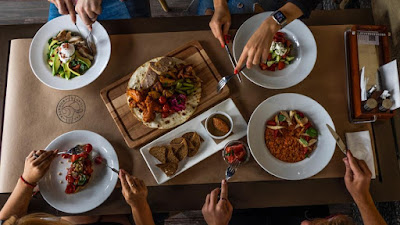Food is a powerful cultural signifier 1
1
Food is a powerful cultural signifier. It can connote inclusiveness, belonging, Attachment, and also be a symbolic expression of societal binding. Grain can Signify exclusiveness, generate feelings and stereotypes of revulsion and disgust, Which demarcate boundaries between the USA and the other. Candy Madeleine illustrates Food can produce good memories as much as Food is nutritional and physiological Requirements as it is cultural, symbolic, and meaningful. Multi-ethnic societies praise Their food diversity and flag it as a marker of inclusiveness. Australian cuisine is supposed to be a representation of cultural and ethnic diversity underpinned by its Culinary variety in foods and tastes. As the food writer Cherry Ripe (1993) asserts, '... we have become some of the most eclectic eaters in the world.' |
| Ethnic Food |
Introduction
Food is a site of struggle where the Federal destabilized and contested, re-invented, re-made, and re-mixed. I examine how representations of Ethnic Food are contextual, discursive, and situated in the competing fields. Where By way of contrast, I explore different cultural Enactments of ethnic foodways within two national milieus. In Australia, culinary multiculturalism celebrated with gusto as a significant feature of national Civilization; by contrast, in Italy, ethnic restaurants are jettisoned from inside the walls.
The town of Lucca -- Tuscany, as its right-wing city council promotes Italian-ness and discourages and segregates any culinary representation which perceived as destabilizing and threatening.
Food is a powerful cultural marker. In the home, the taken-for-granted represented by Food. Safety-net that provides 'ontological security.' Food constitutes,
Abroad One of the imaginary bridges which can keep the individual grounded and connected With the memories of familiar faces, customs, practices, tastes, and smells that were These features highlight the significant role of foodways in displaced communities of diaspora. Immigrants in Brazil eat bacalhau to stay emotionally attached to the Motherland, its customs, traditions, and the relevant others in the 'imagined.
Objectives
1- Shed light on Ethnic Food and risk perception
2- Shed light on Ethnic foods in the global village
3- Shed light on Narratives of ethnic foods and national cuisines
1. Ethnic Food and risk perception
At the "risk society," the Rejection or Acceptance of a new food item Depends on the perception of risk associated with it (Beck, 2000). Some studies have found that cultural Food generally perceived positively most likely because it has already been analyzed by additional People in a different part of the world and does not represent a real Novelty. Unlike other entirely new foods like biotechnological Meals (Backstrom, Partial-Backman, & Tutorial, 2003). One of the main problems perceived by consumers about Ethnic dishes linked to the lack of knowledge about the ingredients used, their origin, and the methods of preparation. Studies in America Have noted that those ethnic cuisines Using components that are Understood and also used at the local cuisine receive a higher level of Confidence among customers (Lee, Node, Simona, & Bruhn, 2012).
Descriptions of the ingredients and preparations of ethnic Dishes also seem to be a strategic foresight by restaurateurs and caterers in directing the consumer to the knowledge and pleasure of different foods (Sloan, 2001). In light of this consideration, the analysis of the risk perceptions, Tastes, and new habits of the Italian people are essential Significance in understanding the impact of these different foods on consumer health.
READ PART 2


Comments